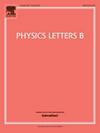A holographic realization of correlation and mutual information
IF 4.5
2区 物理与天体物理
Q1 ASTRONOMY & ASTROPHYSICS
引用次数: 0
Abstract
The status of the inequality existing between mutual information and (normalized) thermal two-point connected correlation function, namely, has been explicitly probed by using the gauge/gravity correspondence. In the holographic analysis, the geodesic approximation for heavy operators () has been used. We observe that the study leads to some non-trivial insights depending upon the method of calculating the thermal object . For a particular computed result of we propose that all of the existing quantum mechanical dependencies (correlations) and classical correlations between the subsystems and vanishes at two different separation lengths, namely, and where .
相关和相互信息的全息实现
利用规范/重力对应关系,明确探讨了互信息与(归一化)热两点连通相关函数I(A:B)≥(< OAOB > β - < OA > β < OB > β)22 < OA2 > β < OB2 > β的不平等状态。在全息分析中,使用了重算子(Δ ~ mR)的测地线近似。我们观察到,根据热对象< O2 > β的计算方法,该研究得出了一些重要的见解。对于< O2 > β的特定计算结果,我们提出子系统a和B之间所有现有的量子力学依赖关系(相关性)和经典相关性在两个不同的分离长度下消失,即sT|c和sT|I,其中sT|I>;sT|c。
本文章由计算机程序翻译,如有差异,请以英文原文为准。
求助全文
约1分钟内获得全文
求助全文
来源期刊

Physics Letters B
物理-物理:综合
CiteScore
9.10
自引率
6.80%
发文量
647
审稿时长
3 months
期刊介绍:
Physics Letters B ensures the rapid publication of important new results in particle physics, nuclear physics and cosmology. Specialized editors are responsible for contributions in experimental nuclear physics, theoretical nuclear physics, experimental high-energy physics, theoretical high-energy physics, and astrophysics.
 求助内容:
求助内容: 应助结果提醒方式:
应助结果提醒方式:


